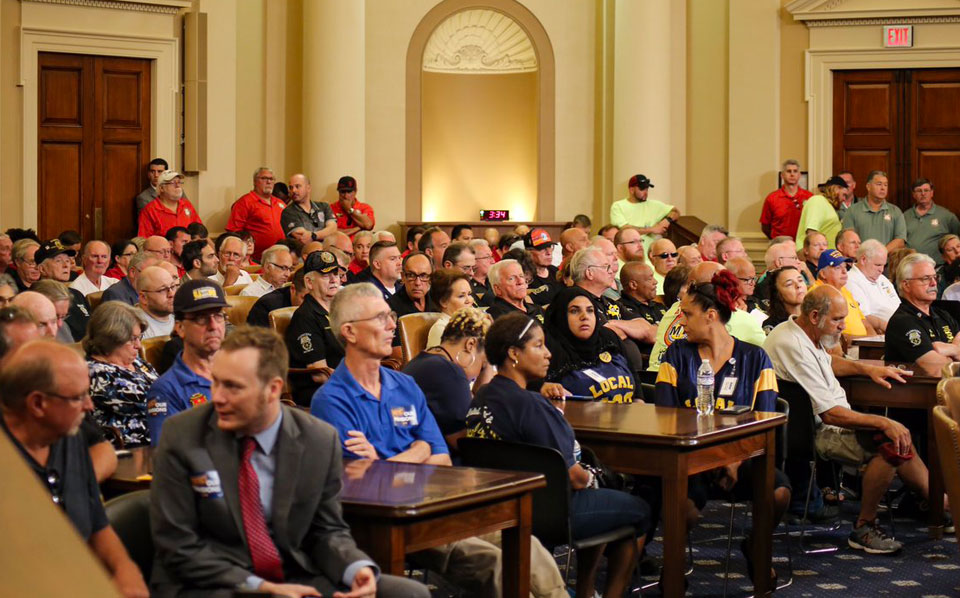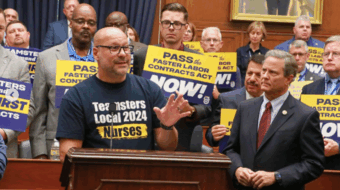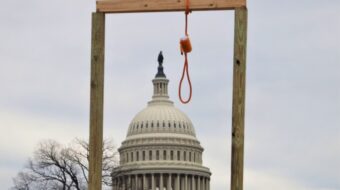
WASHINGTON—At a hearing packed with hundreds of workers, lawmakers on the key committee handling pension issues tackled—and approved—legislation to establish federal loans for troubled multi-employer pension plans.
The measure, HR397, named for Ohio unionist Butch Lewis, who died of a stroke four years ago, would set up a bureau in the Treasury Department to judge applications from the troubled plans. Lewis’s multi-employer plan went broke, and his widow’s pension payout collapsed.
Those plans which can show federal loans would be used to both become solvent and to keep benefits level for current retirees or their families would get funds, repayable after 30 years. The money would come from Treasury bonds.
“We are in the homestretch” of passing HR397, Teamsters President Jim Hoffa said at an outdoor press conference an hour before the July 12 House Ways and Means Committee work session on it. “This is a battle for dignity and for keeping the promises made” to millions of workers. But workers “have to walk the halls” to ensure it passes, he warned.
The multi-employer pension plan problem now affects more than 100 plans serving one million retirees and survivors. Multi-employer plans cover 10 million people overall. They’re common in industries such as trucking, baking and confectionery firms, construction, food processing, and, especially, coal mining.
Joint labor-management boards run the plans, with all employers contributing to the workers’ pensions.
But corporate consolidations, bankruptcies, and especially the crash in pension values and returns from the 2008 financier-caused Great Recession put plans into the “red zone” of financial danger, where they could go broke within months or years.
The Mine Workers’ two pension plans, which the federal government chartered 72 years ago, are in the most immediate danger. The biggest threat is the Teamsters’ giant Central and Southern States pension plan.
And the federal Pension Benefit Guaranty Corporation’s fund to cover those plans—which would pay out far less than workers set aside over the years—is running out of cash, too. The result is huge benefit cuts for workers, like Butch Lewis, who sacrificed pay hikes and lives to ensure pensions, his widow, Rita, said.
“If there’s a better approach than benefit cuts, which the 2014 law led to, I’d like to hear it,” Rep. Ron Kind, D-Wis., challenged the GOP during the work session. He got a round of applause. “It matters that we look out for our people,” added Rep. John Larson, D-Conn.
“This is a solution for everybody, not just Teamsters. These people worked hard for 30 or 40 years to retire with dignity, and we have to make sure that promise is kept,” Hoffa said before.
But Republicans, both on the Ways and Means panel and overall, call the rescue legislation “a bailout.” And Murray Energy, the nation’s largest coal company, also objects. As a result of mergers and bankruptcies, it would fund 97% of one of UMW’s pension funds.
Panel chair Rep. Richard Neal, D-Mass., along with lead co-sponsor Rep. Peter King, R-N.Y., refuted that bailout charge at the outdoor press conference. Another House committee, the Education and Labor Committee, passed HR397 last month on a party-line 26-18 vote. But Ways and Means writes actual pension and tax legislation, so it’s the key House committee in the mix.
“This is not a bailout. What we are proposing is a backstop: The full faith and credit of the U.S. government, which is used every day worldwide,” through the Treasury bonds, Neal explained. “We will construct a structure, a rehabilitation agency, with minimal costs” to run the pension program.
And, addressing defiant Republicans, Neal stated: “I was here for the S&L (savings and loan) crisis. That was a bailout. I was here for” legislation to deal with “Wall Street” after the 2008 crash. “That was a bailout. They (executives) not only kept their jobs” after tanking the U.S. and world economies “but they got bonuses,” Neal said of the financial finaglers.
“This is not a bailout.”
Without the legislation, Rita Lewis said, “It’s not just that one million families will be hurt,” including thousands in her home, Ohio. “It’s our communities. It’s our state,” with a $6 billion annual income loss to Ohioans alone. That’s because pensions would be cut by 40% or more if the retirees or their survivors get anything at all.
“Look at our faces. We matter. We are going to get what we worked for, what we paid for. It’s not a bailout. It’s a loan.”
“I’d ask anyone opposed to this, ‘Did you buy a house? Did you buy a car?’ You took out a loan. This is the same thing.”
Other unions and unionists joined the Teamsters at the outdoor press conference and in the crowded Ways and Means hearing room.
“We’re up here for those who need the attention,” said Larry Greenhill, political director of Electrical Workers (IBEW) Local 26 in Lanham, Md. Though his union’s multi-employer plan is solvent, the original congressional idea, approved in 2014 at the last minute, to have financially healthy plans “bail the others out” didn’t fly, he explained. “This is much better.”
“We’re here for our young brothers’ and sisters’ pensions,” added Local 26 member Jerry Lozupone. “Should we ever get in trouble, we want this to be there for us.” Added Amber Stevens of United Food and Commercial Workers Local 400: “When one is hurt, we all are hurt.”
The legislation, HR397, “offers a real, proactive solution” for the financially ailing plans and the
PBGC, Machinists President Robert Martinez wrote to the Ways and Means panel. It “protects the earned benefits of millions of retirees, workers and their families.”
Plans that get the loans would have to pay pensioners or their families—without benefit cuts—and pay interest on the loans for 30 years, then repay the loan, Martinez explained. Contributing employers would not be able to drop out, but benefits would not increase.
HR397 “is the only solution to date which appropriately and adequately addresses the multi-employer pension crisis by providing a lifeline to plans in critical financial status while maintaining the integrity of healthy plans and the PBGC without cutting into earned benefits,” Martinez wrote.










